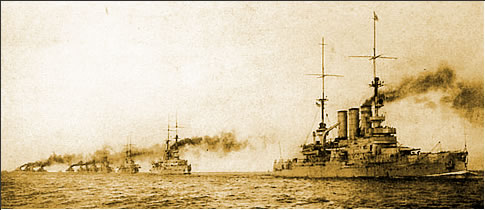The Battle of Jutland
A Comparison of the Fleets
Warships of the German High Seas Fleet set sail from their naval base at Wilhelmshaven. At this point neither the British nor German fleets knew each other was at sea.
The Strength of the Two Fleets
The table below illustrates the size of the British and German fleets at the Battle of Jutland:
 |
 |
 |
|
British Grand Fleet |
|
|
28 |
16 |
|
0 |
6 |
|
9 |
5 |
|
8 |
0 |
|
26 |
11 |
|
77 |
61 |
|
1 |
0 |
|
1 |
0 |
Dimensions of Ships
Below is a comparison of the battlecruiser flagships of Admiral Beatty and Admiral Hipper.
As can be seen from the table, the ships are of similar size but have different strengths and weaknesses.
The British emphasis is on higher speed and bigger guns at the expense of defensive armour. The German emphasis is on greater defensive armour at the expense of higher speed and bigger guns. The German advantage in defensive armour was increased by the fact that British armour-piercing shells frequently failed to explode on impact.

Navigation
+++ Background to the Battle +++
Why did the most powerful naval forces in the world collide at Jutland?
+++ The Admirals +++
Profiles of the commanders of the British and German fleets.
+++ A Comparison of the Fleets +++
A comparison of the strengths and weaknesses of the British Grand Fleet and the German High Seas Fleet.
+++ The Battle Area +++
Map illustrating the battle area of the Battle of Jutland, showing the positions of the British Grand Fleet and German High Seas Fleet at 14.00 hours on 31st May 1916.
+++ The Battle Action at Jutland +++
An animated movie of the Battlecruiser and Main Fleet action as the world's most powerful naval forces unexpectedly collide at Jutland.
+++ Gains and Losses +++
Damage assessment of the British and German fleets following the Battle of Jutland.
+++ Short Term Consequences +++
Quotes relating to the short term consequences of the Battle of Jutland.
+++ Long Term Consequences +++
Quotes relating to the longer term consequences of the Battle of Jutland.
+++ Free eBook: Battle Fleet Action from HMS Neptune +++
Join the look-out in the fore-top of HMS Neptune as Admiral Beatty's battlecruisers lead the German High Seas Fleet into the massed guns of the battleships of the British Grand Fleet.
+++ NEW! The Ultimate Battle of Jutland Resource Pack +++
This unique package is crammed with exclusive diagrams, images and rare hard-to-find resources that would take you weeks to find - even if you knew where to look.
+++ Image Gallery +++
A gallery of photographs displaying the ships and admirals of the British and German fleets that took part in the Battle of Jutland.
+++ Site Map +++
A list of every page on this web site.







